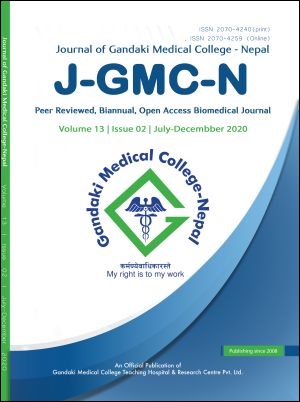Perceived risk, preventive behavior and enabling environment among health workers during COVID-19 pandemic in Nepal: an Online Survey
DOI:
https://doi.org/10.3126/jgmcn.v13i2.31166Keywords:
Perceived risk, enabling environment, health workers, Nepal, Preventive behaviourAbstract
Introduction: Perceived risk, preventive behavior and enabling environment play vital role to prevent COVID-19 transmission in health care settings. The study aimed to assess perceived risk, preventive behavior and enabling environment among healthcare workers of different cadre during COVID-19 pandemic in Nepal.
Methods: A cross sectional online survey was conducted among 427 health workers from April 25 to June 10, 2020. A structured questionnaire was prepared in Google form. Perceived risk was measured using 10 items scale, value ranging from 10 to 50. Descriptive and inferential statistics were computed at 5% level of significance. Ethical approval was taken from Nepal Health Research Council.
Results: Of total, 49.6% respondents were male; 38.4% were from government organizations and 48.0% were doctors. Mean perceived risk was 31.8, 32.8, 31.3 among doctors, nursing professionals and others respectively; and it did not have significant difference among them. However, significant differences were observed in different items of perceived risk across difference cadre of health workers. Most of the health workers reported practice of preventive behavior always or most of the time. Of total, 5.4% doctors and 6.9% other health workers reported they had sometimes access to soap and water. 11.7% doctors, 7.5% nursing professionals and 7.8% other health workers had sometimes access to hand sanitizer; 18.0% doctors, 10.4% nursing professionals and 12.1% other health workers had sometimes access to face mask.
Conclusion: Perceived risk of COVID-19 was high, preventive behavior was satisfactory; but access to enabling environment was poor. Therefore, adequate attention should be given to ensure the availability of protective equipment at work place.
Downloads
Downloads
Published
How to Cite
Issue
Section
License
This license allows reusers to distribute, remix, adapt, and build upon the material in any medium or format for noncommercial purposes only, and only so long as attribution is given to the creator.




